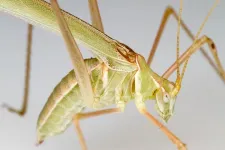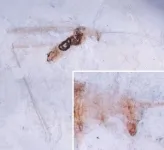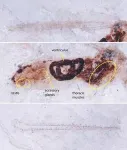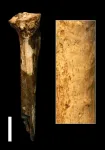(Press-News.org) CHAMPAIGN, Ill. — 50 million years ago in what is now northwestern Colorado, a katydid died, sank to the bottom of a lake and was quickly buried in fine sediments, where it remained until its compressed fossil was recovered in recent years. When researchers examined the fossil under a microscope, they saw that not only had many of the insect’s hard structures been preserved in the compressed shale, so had several internal organs and tissues, which are not normally fossilized.
They describe their findings in the journal Palaeoentomology.
“Katydids are very rare in the fossil record, so any new katydid fossil you find represents a new data point in the evolutionary history of katydids,” said palaeoentomologist and study lead Sam Heads, the director of the Prairie Research Institute’s Center for Paleontology. “But perhaps the most striking feature of this fossil is the really exceptional, remarkable preservation of internal organs – organs that you just don’t see in fossils.”
The fossil was found in the Green River Formation in Rio Blanco County, Colorado. The formation is vast, extending into three states, and is a famous fossil bed in the western U.S. because the fine-grained shales yield a very detailed record of the plants and animals that once inhabited the region, Heads said.
The katydid belongs to the genus Arethaea, a group today known as thread-legged katydids for their extremely slender, grasslike legs, Heads said. The specimen represents a new but extinct species, which Heads and his colleagues named Arethaea solterae after their colleague Leellen Solter.*
“Obviously, having a fossil species of a modern genus is really significant because it confirms the antiquity of this lineage,” Heads said. “Now we know that about 50 million years ago, this genus had already evolved and already had a morphology that mimics the grass in which it lives and hides from predators.”
The find will help scientists understand how this group of insects evolved and when they developed their unique physical structure, he said.
The rare glimpse of soft internal organs in a 50-million-year-old fossil is also remarkable, Heads said.
“Part of the digestive tract is preserved, a part of the midgut we call the ventriculus,” he said. “That’s not so unusual; we have other specimens from this location that have gut traces, so I wasn’t particularly struck by that.”
But when he looked at the specimen under a microscope, Heads saw evidence of other internal structures that he was not expecting to be preserved. There were traces of the fibers making up thoracic muscles associated with the wings or flank muscles. There was some undifferentiated tissue known as a “fat body,” an organ that aids in insect metabolism.
Even more surprisingly, “there are these little tubules that all seem to connect to a round structure – and that can only be a testis and accessory glands that are associated with the testis,” Heads said. “That’s just phenomenal. I was not expecting to see that kind of structure preserved in a rock compression. I’ve never seen that before.”
To double-check his analysis, Heads dissected several katydid specimens of the same genus to match what he was seeing in the fossil.
“They look exactly the same,” he said. “The testis, the accessory glands and the ventriculus were all the same in the present-day katydids. I was just blown away by it. To my knowledge, this is the first example of this level of preservation.”
The Prairie Research Institute is an institute of the University of Illinois Urbana-Champaign.
Editor’s note:
To reach Sam Heads, email swheads@illinois.edu.
The paper “A new fossil katydid of the genus Arethaea Stål (Orthoptera: Tettigoniidae) with exceptionally preserved internal organs from the Eocene Green River Formation of Colorado” is available online or from the U. of I. News Bureau.
*Leellen Solter, a retired insect pathologist and research affiliate of the Illinois Natural History at the Prairie Research Institute, has dedicated her scientific expertise and time to the ongoing project of cataloging and organizing the vast fossil insect collection at the Center for Paleontology.
DOI: 10.11646/palaeoentomology.6.3.10
END
Copenhagen, Denmark: Women are just as likely to give birth to live babies after fertility treatment if embryos are transferred to their wombs three days after fertilisation in the laboratory rather than five. However, the women’s age can affect the outcomes, according to new research presented to the 39th annual meeting of the European Society of Human Reproduction and Embryology (ESHRE) [1].
Dr Simone Cornelisse, a researcher and resident in obstetrics and gynaecology at Radboud University Medical Center, Nijmegen (The Netherlands), told the conference that among 1202 women from 21 Dutch fertility centres who were randomly assigned to have embryos transferred to their wombs ...
Copenhagen, Denmark: Women with polycystic ovary syndrome (PCOS) are not at any greater risk of ovarian cancer than those without the common hormone condition, say researchers. However, those with PCOS who have been through the menopause are more than twice as likely to be diagnosed with ovarian cancer.
The data based on nearly two million women is presented today (Monday) at the 39th annual meeting of the European Society of Human Reproduction and Embryology (ESHRE) [1]. The research is also published simultaneously in the International Journal of Cancer [2].
This ...
Researchers from the Smithsonian’s National Museum of Natural History have identified the oldest decisive evidence of humans’ close evolutionary relatives butchering and likely eating one another.
In a new study published today, June 26, in Scientific Reports, National Museum of Natural History paleoanthropologist Briana Pobiner and her co-authors describe nine cut marks on a 1.45 million-year-old left shin bone from a relative of Homo sapiens found in northern Kenya. Analysis of 3D models of the fossil’s surface revealed ...
Scientists led by Sabine Taschner-Mandl, PhD, St. Anna Children's Cancer Research Institute, and Nikolaus Fortelny, PhD, Paris Lodron University of Salzburg, are the first to analyze bone marrow metastases from childhood tumors of the nervous system using modern single-cell sequencing analysis. It turns out that cancer cells prevent cells in their environment from fighting the tumor – a process that could be reversed with medication. The findings were published in the renowned journal Nature Communications.
Neuroblastoma is the most ...
For many patients with hypertension—an elevated blood pressure that can lead to stroke or heart attack—medication keeps the condition at bay. But what happens when medication that physicians usually prescribe doesn’t work? Known as apparent resistant hypertension (aRH), this form of high blood pressure requires more medication and medical management.
Novel research from investigators in the Smidt Heart Institute at Cedars-Sinai, published today in the peer-reviewed journal Hypertension, found that aRH prevalence was lower in ...
New controlled trial research documents that Progesterone (micronized, oral) is effective at decreasing night sweats and improving sleep in perimenopausal women who have menstruated in the last 1-year. Perimenopausal women most want treatment for these two symptoms.
Current guidelines prescribe Menopausal Hormone Therapy (MHT) for disturbing hot flushes/flashes or night sweats (vasomotor symptoms, VMS) in all women younger than 60 years.
“This guideline assumes that hormone levels and symptoms are the same in the early years of ...
Study reveals some distinctions between Black women in the US and the French Caribbean but increasing trends for aggressive forms in both regions.
Compared with white women, Black women have elevated risks of being diagnosed with advanced uterine cancer—also known as endometrial cancer—and of developing aggressive tumors. Researchers recently compared the incidence and trends for endometrial cancer, both overall and by subtype, between African descent women in Florida and women in the French Caribbean—specifically, the islands of Martinique and Guadeloupe. The findings are published by Wiley online ...
MIAMI, FLORIDA (EMBARGOED UNTIL 3:01 AM ET Monday, June 26, 2023) – Current evidence indicates Black women in the U.S. are at greater risk of developing advanced uterine cancer, also known as endometrial cancer, and of developing its more aggressive form – non-endometroid cancer – than white women.
But research to date has mostly studied Black women as a homogenous group, and there is limited data about specific African-descent subpopulations worldwide. That is until now.
A new study by researchers with Sylvester Comprehensive Cancer Center and the University of Miami Miller School of Medicine compared both the overall incidence and trends for endometrial ...
Orlando, Fla., June 26, 2023 – Facing persistent cases of hospital-onset Methicillin-resistant Staphylococcus aureus (MRSA) during the pandemic, the infection prevention and control (IPC) team at Children’s Hospital New Orleans developed an inexpensive nasal decolonization regimen previously used only in their adult patients that decreased rates of MRSA by 50 percent. Their results are being presented at the Association for Professionals in Infection Control and Epidemiology’s (APIC’s) Annual Conference in Orlando Florida, June 26-28.
Without a lot of scientific literature on nasal decolonization in the pediatric population to guide them, Infection Preventionist ...
Neurosurgical Infections Drop More Than 80% in Two Years at Pittsburgh Hospital
Readmissions, patient satisfaction scores improve through infection preventionist-led, multidisciplinary collaboration
Orlando, Fla. June 26, 2023 – When excess surgical site infections (SSIs) were detected among neurosurgery patients at University of Pittsburgh Medical Center (UPMC) Mercy in 2019, infection preventionist Katie Palladino, MPH, CPH, CIC, partnered with a hospital neurosurgeon on a multidisciplinary quality and process improvement initiative that ...






